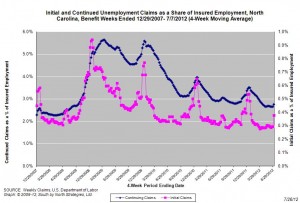Not As Fair As It Sounds
Off the Charts nicely shows how across-the-board cuts in income tax rates disproportionately benefit the richest Americans.
Off the Charts nicely shows how across-the-board cuts in income tax rates disproportionately benefit the richest Americans.
Economic policy reports, blog postings, and media stories of interest:
CHAPEL HILL (July 27, 2012) – Between June 2011 and June 2012, unemployment rates fell in 91 of North Carolina’s 100 counties and in all 14 of the state’s metropolitan areas. Over that same period, labor force sizes contracted or held steady in 59 counties and in three metro areas. These findings come from new estimates prepared by the Labor and Economic Analysis Division of the North Carolina Department of Commerce.
“Local unemployment rates fell across much of North Carolina over the past year, yet local unemployment rates remain extremely elevated despite the improvements,” said John Quinterno, a principal with South by North Strategies, Ltd., a research firm specializing in economic and social policy. “While unemployment rates fell in 91 counties and in all 14 metro areas over the year, unemployment rates at or above 10 percent were found in 61 counties and in eight metros.”
Compared to December 2007, which is when the economy fell into recession, North Carolina has 5.1 percent fewer jobs (-213,600) and has seen its unadjusted unemployment rate climb from 4.7 percent to 9.9 percent. In June, the state gained 16,900 more payroll jobs than it lost. Since bottoming out in February 2010, the state’s labor market has netted an average of 4,025 jobs per month, resulting in a cumulative gain of 112,700 positions (+2.9 percent).
Between May and June, unemployment rates rose in 84 counties, with 61 percent of the state’s counties posting unemployment rates of at least 10 percent. Individual county rates ranged from 5.3 percent in Currituck County to 17.6 percent in Scotland County. Compared to the prior month, unemployment rates were higher in 84 counties, lower in 11 counties, and unchanged in five counties.
“Non-metropolitan labor markets continue to struggle relative to metropolitan ones,” added Quinterno. “In June, 10.9 percent of the non-metro labor force was unemployed, compared to 9.4 percent of the metro labor force. Compared to December 2007, the non-metro labor force is now 0.4 percent smaller in size, while 6.1 percent fewer persons are employed. Meanwhile, the number of unemployed rural persons has grown by 96.8 percent and now totals 146,129. Over the year, the non-metro labor force has declined by 1.3 percent, or 17,531 persons.”
Over the month, unemployment rates rose in all 14 of the state’s metro areas. Rocky Mount had the highest unemployment rate (13.2 percent), followed by Hickory-Morganton-Lenoir (11.2 percent). Durham-Chapel Hill and Asheville were tied for the lowest unemployment rate (7.9 percent), followed by Raleigh-Cary (8 percent) and Goldsboro (9 percent).
Compared to June 2011, unemployment rates were lower in 91 counties and in all 14 metros. Over the year, labor force sizes contracted or held steady in 59 counties and in three metros. Among metros, Wilmington’s labor force contracted at the fastest rate (-2.2 percent), followed by Hickory-Morganton-Lenoir and Greenville (tied at -0.1 percent). With those changes, metro areas now are home to 71.6 percent of the state’s labor force, with half of the labor force resident in the Triangle, Triad, and Charlotte metros.
In the long term, any meaningful recovery will hinge on economic and employment growth in the Charlotte, Research Triangle, and Piedmont Triad regions. Yet growth remains weak. Collectively, employment in these three metro regions has risen by just 1.1 percent since December 2007, and the combined June unemployment rate in the three regions equaled 9.2, down from the 10.3 percent rate recorded one year ago. Of the three broad regions, the Research Triangle had the lowest unemployment rate (8.2 percent), followed by the Piedmont Triad (10 percent), and Charlotte (10.2 percent).
“Local unemployment rates fell across much of North Carolina over the past year, yet local labor markets remain distressed,” said Quinterno. “Unemployment rates remain elevated, and nearly 500,000 North Carolinians are unemployed. For North Carolinians who want and need jobs, conditions simply are not improving fast enough.”
For the benefit week ending on July 7 2012, some 23,838 North Carolinians filed initial claims for state unemployment insurance benefits and 115,156 individuals applied for state-funded continuing benefits. Compared to the prior week, there were more initial and more continuing claims. These figures come from data released by the U.S. Department of Labor.
Averaging new and continuing claims over a four-week period — a process that helps adjust for seasonal fluctuations and better illustrates trends — shows that an average of 14,172 initial claims were filed over the previous four weeks, along with an average of 103,650 continuing claims. Compared to the previous four-week period, the average number of initial claims was higher, as was the average number of continuing claims .
One year ago, the four-week average for initial claims stood at 13,837, and the four-week average of continuing claims equaled 112,502.
In recent weeks covered employment has increased and now exceeds the level recorded a year ago (3.8 million versus 3.7 million). Nevertheless, there are still fewer covered workers than there were in January 2008, which means that payrolls are smaller today than they were over four years ago.
The graph shows the changes in unemployment insurance claims measured as a share of covered employment in North Carolina since the recession’s start in December 2007. 
Both new and continuing claims appear to have peaked for this cycle, and the four-week averages of new and continuing claims have fallen considerably. Yet continuing claims remain at an elevated level, which suggests that unemployed individuals are finding it difficult to find new positions.
Economic policy reports, blog postings, and media stories of interest: